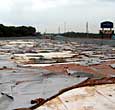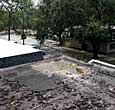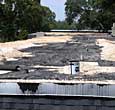(321) 356-0218




Behind many common roof problems lie errors in design, materials and maintenance, Each type of failure causation - blisters, splits and punctures, to name a few - typically result from a specific cause. Poor design, for example, can lead to splits, and debris can cause punctures. Poor workmanship and material failures can lead to a shortened roofing life – and costly remedies.
Why Roofs Fail
Blisters
Blisters are the most common roofing problem. They occur when a gas, usually water vapor, is trapped within the roofing system either between the plies or between the plies and the insulation. Solar heat causes the gas to expand which creates a pressure within the system that pushes the plies apart.
Splitting
The most common splits occur when a metal accessory is flashed with a membrane material. As the temperature changes, metals and membranes expand and contract at very different rates.
Open Laps
Open laps in the field membrane and in flashings, are another problem. Open laps are commonly carelessness and nonconformance with the specifications. Open laps in built-up and modified bitumen systems can occur when the bitumen is applied too cold. In single-ply membranes, open laps are usually caused by improper surface preparation and deficient adhesive application.
Punctures
The most preventable failure symptom, punctures usually occur because of carelessness on the part of people visiting the roof: HVAC technicians, window washers, painters, maintenance staff, smokers and tenants.
Penetrations
Another common failure location is penetrations. Of particular concern are pitch pans. If a penetration is not thoroughly cleaned of asphalt before installing pourable sealers, the sealer will not adhere to the penetration.
Wrinkles
Wrinkles can occur both in the flashings and within the membrane itself. The opening left at the end of the wrinkle is called a “fish mouth” – and an invite for easy water penetration.
Flashings
Failures at flashings commonly occur due to improper fastening, lapping and sealing.
Surfacing
Surfacing on membranes usually provide protection from ultraviolet radiation and damage from traffic on the roof. When the surfacing gets displaced or worn off, this protection no longer applies.
Fasteners
Fasteners must provide adequate wind lift resistance, especially in coastal areas. In mechanically attached roofing systems, wind and thermal forces can cause movement on the fasteners, leaving unsealed holes for water entry.
Mr. Albers is an expert witness in a court of law, but is not an attorney. If you have legal questions related to any of these topics, please consult an Attorney.

